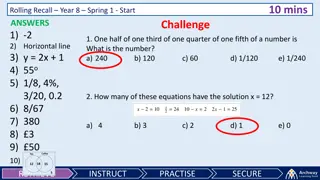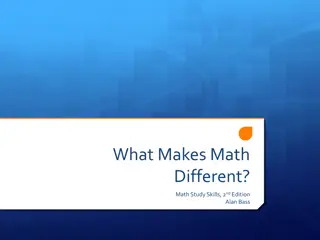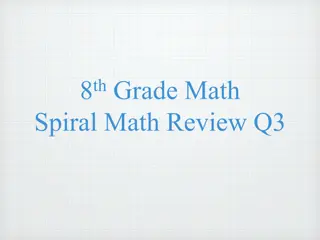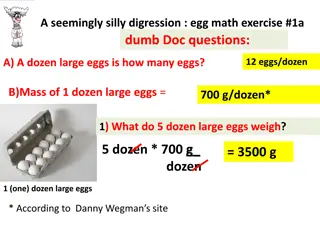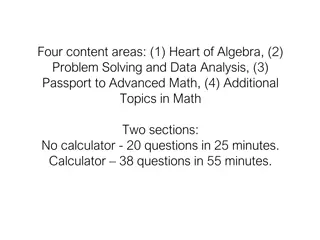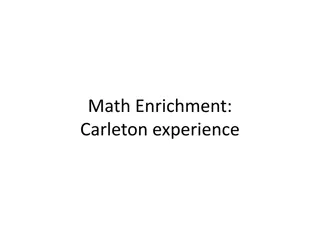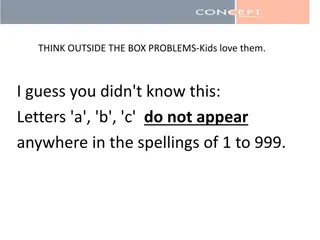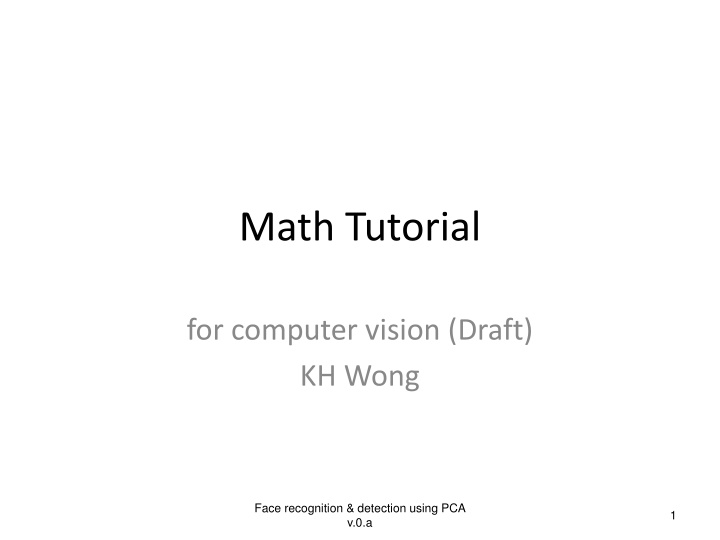
Computer Vision Tutorial for Face Recognition & Detection using PCA
Explore a comprehensive math tutorial for computer vision focusing on face recognition and detection using PCA. Dive into topics such as basic and advanced geometry, linear algebra, non-linear optimization, probability, points and lines in 2D and 3D, and more. Enhance your understanding of image processing techniques essential for computer vision applications.
Download Presentation

Please find below an Image/Link to download the presentation.
The content on the website is provided AS IS for your information and personal use only. It may not be sold, licensed, or shared on other websites without obtaining consent from the author. If you encounter any issues during the download, it is possible that the publisher has removed the file from their server.
You are allowed to download the files provided on this website for personal or commercial use, subject to the condition that they are used lawfully. All files are the property of their respective owners.
The content on the website is provided AS IS for your information and personal use only. It may not be sold, licensed, or shared on other websites without obtaining consent from the author.
E N D
Presentation Transcript
Math Tutorial for computer vision (Draft) KH Wong Face recognition & detection using PCA v.0.a 1
Overview Basic geometry 2D 3D Linear Algebra Eigen values and vectors Ax=b Ax=b and SVD Non-linear optimization Jacobian Probability vs likelihood (maximum likelihood) Face recognition & detection using PCA 2 v.0.a
2D- Basic Geometry 2D homogeneous representation A point x has x1,x2 components. To make it easier to operate, we use Homogenous representation. Homogeneous points, lines are in the form of 3x1 vectors. So a Point x=[x1,x2,1] , a line is L: [a,b,c] Properties of points and lines If point x is on the line L2 x *L=[x1,x2,1]*[a,b,c] =0, see operation is a linear one, very easy. We can get back to the line form we all recognize: ax1+bx2+c=0. L1=[a,b,c] and L2=[e f g] intersects at Xc Xc=(L1 X L2), intersection point = cross product of the 2 lines. The line through two points a=[a1,a2,1] , b=[b1,b2,1] is L=a X b Plane Face recognition & detection using PCA v.0.a 3
2D- Advanced topics : Points and lines at infinity Point at infinity (ideal point) : Point of intersection of two parallel lines L1=(a,b,c), L2=(a.b.c ), L1 L2 have the same gradient Is [b,-a,0] Proof Pintersect=L1 L2= |x y z| |a b c| |a b c | Xbc +acy+abz-abz-bcx-ac y= xbc bcx+acy-ac y=(c -c)bx+(c -c)(-a)y+0z Pintersect=(c -c)(b,-a,0) , Ignor the scale (c-c ), (b,-a,0) Is a point in infinity, the third element is 0, if we convert it back to inhomogeneous coordinates: [x=b/0= , -a/0= ] Line at infinity (L ): L =[0 0 1] . A line passing through these infinity points is at infinity. It is called L which satisfies L x =0. We can see that L =[0 0 1] , since L =[0 0 1] x = [0 0 1] [x1 x2 0] =0. (*Note that if the dot product of the transpose of a point to a line is 0, the point is on that line.) Face recognition & detection using PCA v.0.a 4
2D- Ideal points: (points at infinity) Pideal (ideal point) = [a,-b,0] is the point where a line L1=[a,b,c] and the line at infinity L =[0 0 1] meets. Proof (Note : the point of intersection of lines L1, L2 = L1 L2.) Pideal=L1 L = |x y z| |a b c|=xb-ay+0z=a point at [b a 0] |0 0 1| Hence Pideal=[ b a 0], no c involved. It doesn t depend on c, so any lines parallel to L1 will meet L at Pideal. Face recognition & detection using PCA v.0.a 5
3D- homogeneous point A homogeneous point in 3D is X=[x1,x2,x3,x4] Face recognition & detection using PCA v.0.a 6
3D- Homogenous representation of a plane The homogenous representation of a plane is represented by Ax1+Bx2+Cx3+Dx4=0 or x=0 where =[A,B,C,D] and x=[x1,x2,x3,x4] . And the inhomogeneous coordinates can be obtained by X=x1/x4 Y=x2/x4 Z=x3/x4 Face recognition & detection using PCA v.0.a 7
3D- Normal and distance from the origin to a plane The inhomogeneous representation of the plane can be written as [ 1, 2, 3] [X,Y,Z] +d=0, where n=[ 1, 2, 3] is a vector normal to the plane and is the distant from the origin to the plane along the normal. Comparing it with the homogeneous representation we can map the presentations as follows. The normal to the plane is n=[ 1, 2, 3] The distance from the origin to the plane is d= 4. Face recognition & detection using PCA v.0.a 8
3D- Three points define a plane Three homogeneous 3D points A=[a1, a2, a3, a4] B=[b1, b2, b3, b4] C=[c1, c2, c3,c4] If they lie on a plane =[ 1, 2, 3, 4] [A ,B ,C ] =0 Face recognition & detection using PCA v.0.a 9
3D- 3 planes can meet at one point, if it exist, where is it? Face recognition & detection using PCA v.0.a 10
Basic Matrix operation (AB)T=BT AT If Orthogonal is R square a is R matrix real entries with columns and rows = I orthogonal are unit vectors = T T and R R RR = 1 T R R http : //en.wikip edia.org/w iki/Orthog onal_matri x Face recognition & detection using PCA v.0.a 11
Rank of matrix http://en.wikipedia.org/wiki/Rank_(linear_algebra) If A is of size m x n, Rank(A)<min{m,n} Rank(AB)< min{rank(A), rank(B)} Rank(A)= number of non zero singular values found using SVD. Face recognition & detection using PCA v.0.a 12
Linear least square problems Eigen values and vectors Two major problems Ax=b Ax=0 Face recognition & detection using PCA v.0.a 13
For 1=-2, (A- 1I)v=0, A=[-3- 1 , -1 [4 , 2- 1 ]v2]=0 -v1-v2=0, and 4v1+4v2=0 (2 duplicated eqn.s) V is a vector passing through 0,0, set v2=1,so V1=-1, v2=1 is the direction of the vector v The eignen vector for eigen value 1=-2 is [v1=-1,v2=1] -------------------------------------- For 2=1, (A- 2I)v=0, A=[-3- 2 , -1 ][v1] [4 , 2- 2][v2]=0 -4v1-v2=0, and 4v1+v2=0, (2 duplicated eqn.s) The eignen vector for eigen value 2=1 is v1=- 1,v2=4 ][v1] Eigen value tutorial A is an m x n matrix, Av= v, where v =[v1 v2 .]Tis an nx1 vector , is a scalar (Eigen value) By definition (A- I)v=0, So, det (A- I)=0 Example 1, A is 2 x2, so v =[v1 v2]T A=[-3 -1 ] [ 4 2 ], Det[-3- , -1 ] [ 4 , 2- ]=0 -6+ -2 + 2-4(-1)=0 2 - -6=0 Solve for , Eigen values: 1=-2, 2=1 Ref: http://www.math.hmc.edu/calculus/tutorials/eigenstuff/ http://www.arndt-bruenner.de/mathe/scripts/engl_eigenwert2.htm Face recognition & detection using PCA v.0.a 14
Eigen value tutorial Example 2, m=2, n=2 A=[1 13 13 1], Det[1- , 13 13 , 1- ]=0 (1- )2-2(1- )+132=0 Solve for , solutions: 1=-12, 2=14 for Eigenvalue -12: Eigenvector: [ -1 ; 1 ] for Eigenvalue 14: Eigenvector: [ 1 ; 1 ] Ref: Check the answer using http://www.arndt-bruenner.de/mathe/scripts/engl_eigenwert2.htm Face recognition & detection using PCA v.0.a 15
Ax=b problem Case1 :if A is a square matrix Ax=b, given A and b find x Multiple A-1 on both sides: A-1 Ax= A-1 b X= A-1 b is the solution. Face recognition & detection using PCA v.0.a 16
Ax=b problem Case2 :if A is not a square matrix Ax=b, given A and b find x Multiple AT on both sides: AT Ax= AT b (AT A)-1 (AT A)x= (AT A)-1 AT b X=(AT A)-1 AT b is the solution Face recognition & detection using PCA v.0.a 17
Ax=b problem Case2 :if A is not a square matrix Alternative proof Numerical method and software by D Kahaner, Page 201 Ax=b, given Amxn and bmx1 find xnx1 To minimize 2 2 = b Ax ( ) ( )( ) ) ( b + T = 2 b Ax b Ax ( b )( ) = = T T T T T ( ) b Ax b Ax b x A b Ax = T T T T T T b b Ax x A x A Ax Each of the above terms is scalar, a and 1 ( ) ( ) 1 x n ( ) T = = rd T T T The 3 term on the right , A b b Ax 1 m n m 1 ( ) T T T so the = value of is the same that as of b + Ax b Ax 2 T T T T 2 b b b Ax x A Ax 2 ( dx = ) d = + = 2 T T 2 2 in 0 order to minimise hence , A b A Ax 1 T T ( ) ( ) x A A A b Face recognition & detection using PCA v.0.a 18
Solve Ax=0 To solve Ax=0, Homogeneous systems One solution is x=0, but it is trivial and no use. We need another method, SVD (Singular value decomposition) Face recognition & detection using PCA v.0.a 19
SVD for Homogeneous systems norm p To solve Ax=0, 1 n p = i p = , x x (Homogeneous systems) One solution is x=0, but it is trivial and no usage. If we set ||x||2=1, the solution will make sense. So we ask a different question: find min(||Ax||2) and subject to ||x||2=1. Note:||x||2 is 2-norm- sqaure of x Good tutorial at https://math.stackexchange.com/questions/1771013/null-space-from-svd i _ p norm = special A case p 2 Frobenius the is norm 2 or ( or ) Euclidean norm l -norm n = i 2 = = x x x i 2 _ norm http://en.wikipedia.org/wiki/Matrix_norm Face recognition & detection using PCA v.0.a 20
What is SVD? Singular value decomposition A is mxn, decompose it into 3 matrices: U, S, V. [U,S,V]=svd(A), can get back A by A=U*S*VT U is mxm is an orthogonal matrix S is mxn (diagonal matrix) V is nxn is an orthogonal matrix 1, 2, n, are singular values Columns of vectors of U=left singular vectors Columns of vectors of V=right singular vectors If Orthogonal is R square a is R matrix real entries with columns and rows = I orthogonal are unit vectors = T T and R R RR = 1 T R R http : //en.wikip edia.org/w iki/Orthog onal_matri x = T A U S V m m m n n n 0 1 2 = . S . 0 n ... 0 1 2 n Good tutorial at https://math.stackexchange.com/questions/1771013/null-space-from-svd GloVe ver.0.1.a3 21
SVD (singular value decomposition) Singular values Right singular vectors (after transposition of v) SVD Left singular vectors T . . . . . . U U V V 0 1 , 1 , 1 1 , 1 , 1 m n 1 . . . . . . . . . . 2 = . . . . . . . . . . ( ) . A m n . . . . . . . . . . . U . . . . . . U V V 0 1 , , 1 , , m m m n n n n ... 1 2 n Relation w eigen valu ith es = T ( ) A A x x T eigen val ues of ( ) are .. A A 1 2 n = = ,,n 1 j j j GloVe ver.0.1.a3 22
More properties Meaning of i is = 2 1 2 2 2 T Eigen values of , ,.., . A A n Define = = Columns of vectors of U left singular v ectors u i Columns = .. .. U u u v 1 i of m = = vectors of V right singular v ectors v i A = .. = .. V v v v 1 i n 2 T ( ) A u u i i 2 i = T ( ) AA v v i i i GloVe ver.0.1.a3 23
Demo matlab program 'SVD demo -- khw 2020 oct' 'start with a 4x3 matrix, m=3,n=4' a=[1 4 7 10 6 5 8 11 3 2 9 12] 'Run SVD to get 3 matrices u,s,v. Size: u=3x3, s=3x4,v=4x4' [u,s,v]=svd(a) 'the transpose of v is =' v' 'can form back the original matrix by u*v*v' aa=u*s*v' 'rank of a and aa' rank(a),rank(aa) 'checking, norm() should be small' norm(a-aa) 'left singular m=3 vectors are ' u(:,1),u(:,2),u(:,3),'singular values=' diag(s) 'Right singular 4=n vectors are ' v(:,1),v(:,2),v(:,3),v(:,4) a =[ 1 4 7 10 6 5 8 11 3 2 9 12] SVD to get u,s,v. Size: u=3x3, s=3x4,v=4x4 u =[-0.5043 -0.4495 -0.7373 -0.6137 0.7872 -0.0602 -0.6075 -0.4221 0.6729] s =[25.1675 0 0 0 0 3.4570 0 0 0 0 2.1554 0] v =[-0.2388 0.8699 0.4268 0.0640 -0.2503 0.3742 -0.8837 -0.1280 -0.5526 -0.1875 0.1914 -0.7892 -0.7583 -0.2608 0.0179 0.5972] the transpose of v is = [ -0.2388 -0.2503 -0.5526 -0.7583 0.8699 0.3742 -0.1875 -0.2608 0.4268 -0.8837 0.1914 0.0179 0.0640 -0.1280 -0.7892 0.5972] 3 Left singular vectors Each is 3x1 3 singular values: s=[ 1 0 0 0 0 2 0 0 0 0 3 0] 4 Right singular vectors Each is 4x1 You can get back a from u,s,v, i.e. a=u*s*vT GloVe ver.0.1.a3 24
Find Ax=0 , x=0 is not a true solution, we prefer x is not zero, so we ask to minimize ||Ax||2 subject to ||x||2=1 Recall 2-norm(x)= ||x||2=sqrt(x12+x12+..+xn2 ), if the vector x=[x1, x2,.., xn] , where ( )=transpose. We want to minimize ||Ax||2. Use SVD, A=USV ||Ax||2 =||USV x||2 = (USV x) (USV x) since by definition 2-norm-sqaure: ||Y||2=Y Y hence ||Ax||2 = (x VS U )(USV x), as (ABC) =C B A so||Ax||2 =(x VS SV x). We know that U is orthogonal, that is U U=1 Since x VS = (SV x) put back to the above formula, So ||Ax||2 =(SV x) (SV x) =||SV x||2 To minimize ||Ax||2 subject to ||x||2=1, or same as minimize ||SV x||2 subject to ||V x||2=1 (because =||x||2=||V x||2, see ** on the right) Set y=V x. We know that S is size (mxn) (diagonal matrix), V is size (nxn), y and x is size (nx1). We now minimize ||Ax||2 or ||S(mxn)y(nx1)||2 subject to ||y||2=1 Since S is diagonal and with descending entries If you choose y=[0, 0,..,0, 1]T (reason: ||y||2=1 is satisfied, and ||S(mxn)y(nx1)||2 is the smallest. Because we set earlier V x=y, so x=(V )-1 y . We know that V is orthogonal, (V )-1=V, hence x=Vy, therefore xsolution=V[0, 0,..,0, 1]T =last column of V ** To show ||x||2=||V x||2 Proof: ||V x||2=(V x) (V x) =x V(V x) =x xsince VV =I , (V is orthogonal) =||x||2, done If Orthogonal is = R R = T T and R R RR I = 1 T R 0 1 2 = . S n= smallest . 0 n Face recognition & detection using PCA v.0.a 25
Nonlinear leave square Jacobian Face recognition & detection using PCA v.0.a 26
Non-linear optimization To be added Face recognition & detection using PCA v.0.a 27
Some math background on statistics 1. Mean, Variance/ standard deviation 2. Covariance and Covariance matrix 3. Eigen value and Eigen vector Face recognition & detection using PCA v.0.a 28
Mathematical methods in Statistics 1. Mean, variance (var) and standard_deviation (std), Face recognition & detection using PCA v.0.a 29
Revision of basic statistical methods: Mean, variance (var) and standard_deviation (std) x = 2.5000 0.5000 2.2000 1.9000 3.1000 2.3000 2.0000 1.0000 1.5000 1.1000 mean_x = 1.8100 var_x = 0.6166 std_x = 0.7852 1 n n = = = = mean x x i 1 i 2 1 n ( ) = = var( ) x x i ) 1 ( n 1 i = ( ) var( ) std x x %matlab code x=[2.5 0.5 2.2 1.9 3.1 2.3 2 1 1.5 1.1]' mean_x=mean(x) var_x=var(x) std_x=std(x) x sample Face recognition & detection using PCA v.0.a 30
n or n-1 as denominator?? see http://stackoverflow.com/questions/3256798/why-does-matlab-native-function-cov- covariance-matrix-computation-use-a-differe n-1 is the correct denominator to use in computation of variance. It is what's known as Bessel's correction (http://en.wikipedia.org/wiki/Bessel%27s_corr ection) Simply put, 1/(n-1) produces a more accurate expected estimate of the variance than 1/n Face recognition & detection using PCA v.0.a 31
1 n n = = = = mean x x i Class exercise 1 1 i 2 1 n ( ) = = var( ) x x i ) 1 ( n 1 i = ( ) var( ) std x x By computer (Matlab) x=[1 3 5 10 12]' mean(x) var(x) std(x) Mean(x) = 6.2000 Variance(x)= 21.7000 Stand deviation = 4.6583 By and x=[1 3 5 10 12]' mean= Variance= Standard deviation= %class exercise1 x=[1 3 5 10 12]' mean(x) var(x) std(x) 32 Face recognition & detection using PCA v.0.a
1 n n = = = = mean x x i 1 i Answer1: 2 1 n ( ) = = var( ) x x i ) 1 ( n 1 i = ( ) var( ) std x x By computer (Matlab) x=[1 3 5 10 12]' mean(x) var(x) std(x) Mean(x) = 6.2000 Variance(x)= 21.7000 Stand deviation = 4.6583 By and x=[1 3 5 10 12]' mean=(1+3+5+10+12)/5 =6.2 Variance=((1-6.2)^2+(3- 6.2)^2+(5-6.2)^2+(10- 6.2)^2+(12-6.2)^2)/(5- 1)=21.7 Standard deviation= sqrt(21.7)= 4.6583 Face recognition & detection using PCA v.0.a 33
Mathematical methods in Statistics 2. a) Covariance b) Covariance (variance-covariance) matrix Face recognition & detection using PCA v.0.a 34
Part 2a: Covariance [see wolfram mathworld] http://mathworld.wolfram.com/ Covariance is a measure of the extent to which corresponding elements from two sets of ordered data move in the same direction. http://stattrek.com/matrix-algebra/variance.aspx x : y : 1 1 = = , X Y x y n n ( )( ) N x x y y = i = covariance ( , ) X Y i i 1 N 1 Face recognition & detection using PCA v.0.a 35
Part 2b: Covariance (Variance-Covariance) matrix Variance-Covariance Matrix: Variance and covariance are often displayed together in a variance- covariance matrix. The variances appear along the diagonal and covariance appear in the off- diagonal elements , http://stattrek.com/matrix-algebra/variance.aspx Note: x has N samples (rows) of C variables (columns), cov(x)=(1/n-1)(x *x) Assume you have C sets of data Each . has entries. X ,X ,..,X N = = = 1 2 c c c C c=1 c=2 c=C x 1 , c : = = , ( ) X X mean X c c c _matrix x Xc , c N N = covariance ( , ) X Y N N N ( )( ) ( )( ) ( )( ) = N = N = N .. x X x X x X x X x X x X , 1 1 , 1 1 , 1 1 , 2 2 , 1 1 , i i i i i c i c 1 1 1 i i i ( )( ) ( )( ) ( )( ) = i = i = i 1 .. x X x X x X x X x X x X , 2 2 , 1 1 , 2 2 , 2 2 , 2 2 , i i i i i c i c ( ) 1 N 1 1 1 : : : : N N N ( )( ) ( )( ) ( )( ) = i = i = i .. x X x X x X x X x X x X , , 1 , , 2 2 , , C i C i C C i C i C i C c i c 1 1 1 Face recognition & detection using PCA v.0.a 36
Find covariance matrix cov() of an input data set Assume the measurements (x or y) have zero mean to simply the discussion Different people make their preferred format of measurement matrices, but If the measurement matrix (x(nxc)) has N samples (rows) of C variables (columns) then the covariance matrix of x is cov(x)(cxc)=(1/n-1)(x *x) If the measurement matrix (y(cxn)) has N samples (columns) of C variables (rows) then the covariance matrix of y is cov(y)(cxc) =(1/n-1)(y*y ) This is to make sure the covariance matrix is a square matrix of size cxc= number_of_variables x number_of_variables Face recognition & detection using PCA v.0.a 37
Application of covariance matrix You perform M sets of measurements, each measurement has n parameters (variables) E.g. Four days of temperature, rain-fall (in mm), wind-speed (km per hour) The data collected is placed in matrix A. E.g. Rows: each row is a measurement of different variables Columns: each column is a variable on different days A(Mxn) = [-1 1 2 ; -2 3 1 ; 4 0 3 ; 1 2 0](Mxn, or 4x3) Temperature is -1 on day1 Wind-speed is 3 on day3 Face recognition & detection using PCA v.0.a 38
Covariance matrix example1 A is 4x3 From Matlab >help cov Consider A = [-1 1 2 ; -2 3 1 ; 4 0 3 ; 1 2 0] To obtain a vector of variances for each column of A: v = diag(cov(A))' v = 7.0000 1.6667 1.6667 Compare vector v with covariance C=cov(A); C=[7.0000 -2.6667 1.6667 -2.6667 1.6667 -1.3333 1.6667 -1.3333 1.6667] Ie. Take the first column of A a=[-1,-2,4,1] a2=a-mean(a) a2=[-1,-2,4,1] -0.5=[-1.5000,-2.5000, 3.5000, 0.5000] Cov([-1,-2,4,1] )=7 Cov(a)=7 a2 *a2/(N-1)= [-1.5000,-2.5000,3.5000,0.5000]* [-1.5000,-2.5000,3.5000,0.5000] /(4-1) =7 Diagonals are variances of the columns Covariance of first and second column >> cov([-1,-2,4,1]',[1,3,0,2]')= 7.0000 -2.6667 -2.6667 1.6667 Also >> cov([1,3,0,2]',[2,1,3,0]') = 1.6667 -1.3333 -1.3333 1.6667 Face recognition & detection using PCA v.0.a 39
Covariance matrix example2 A is 3x3 From Matlab >help cov Consider A = [-1 1 2 ; -2 3 1 ; 4 0 3]. To obtain a vector of variances for each column of A: v = diag(cov(A))' v = 10.3333 2.3333 1.0000 Compare vector v with covariance matrix C: C = 10.3333 -4.1667 3.0000 -4.1667 2.3333 -1.5000 3.0000 -1.5000 1.0000 Ie. Take the first column of A a=[-1,-2,4] a2=a-mean(a) a2=[-1,-2,4] -0.333=[-1.3333 - 2.3333 3.6667] Cov([-1,-2,4] )= Cov(a)= a2 *a2/(N-1)= [-1.3333 -2.3333 3.6667] *[-1.3333 -2.3333 3.6667]/(3-1) =10.333 Diagonals are variances of the columns Covariance of first and second column >> cov([-1 -2 4]',[1 3 0]')= 10.3333 -4.1667 -4.1667 2.3333 Also >> cov([1 3 0]',[2 1 3]') = 2.3333 -1.5000 -1.5000 1.0000 Face recognition & detection using PCA v.0.a 40
Covariance matrix example Ie. Take the first column of A a=[-1,-2,4] a2=a-mean(a) a2=[-1,-2,4] -0.333=[-1.3333 -2.3333 3.6667] b=[1 3 0] b2=[1 3 0] -mean(b)= b2= [-0.3333 , 1.6667, -1.3333] a2 *b2/(N-1)=[-1.3333 -2.3333 3.6667]*[-0.3333 , 1.6667, -1.3333] = -4.1667 ------------------------------------------ C=[2 1 3] C2=[2 1 3] -mean(c) C2=[2 1 3] -2=[0 -1 1] a2 *c2/(N-1)=[-1.3333 -2.3333 3.6667]*[0 -1 1] /(3-1)=3 ----------------------------------- b2*b2 /(N-1)=[-0.3333 , 1.6667, - 1.3333]*[-0.3333 , 1.6667, - 1.3333] /(3-1)=2.3333 b2*c2/(N-1)= [-0.3333 , 1.6667, - 1.3333]*[0 -1 1] /(3-1)=-1.5 From Matlab >help cov Consider A = [-1 1 2 ; -2 3 1 ; 4 0 3]. To obtain a vector of variances for each column of A: v = diag(cov(A))' v = 10.3333 2.3333 1.0000 Compare vector v with covariance matrix C: C = 10.3333 -4.1667 3.0000 -4.1667 2.3333 -1.5000 3.0000 -1.5000 1.0000 N=3, because A is 3x3 Face recognition & detection using PCA v.0.a 41
Mathematical methods in Statistics 3. Eigen value and Eigen vector Face recognition & detection using PCA v.0.a 42
Eigen vectors of a square matrix Because A is rank2 and is 2x2 cov_x * X= X, so cov_x has 2 eigen values and 2 vectors In Matlab [eigvec,eigval] =eign(cov_x) Square matrix eigvect of cov_x = [-0.7352 0.6779] [ 0.6779 0.7352] covariance_matrix of X = cov_x= [0.6166 0.6154] [0.6154 0.7166] eigval of cov_x = [0.0492 0] [ 0 1.2840 ] So eigen value 1= 0.49, its eigen vector is [-0.7352 0.6779] eigen value 2= 1.2840, its eigen vector is [0.6779 0.7352] Face recognition & detection using PCA v.0.a 43
To find eigen values x x + + = 2 ( ) ( ) 0 d a ad bc 1 1 = A x x solution t this o quadratic equation 2 2 d c + 1 2 ( ) ( ) ( 4 ) d a d a ad bc x x a b = 1 1 = 2 x x So c if a b 2 2 = ax ( bx ) x 0 6166 . 0 6154 . 2 1 = 0 6154 . 0 7166 . d = ( ) a x bx i 1 2 2 ( ) ( ) ( 4 ) d a d a ad bc = 2 + = cx dx ( x ) = ( 0 7166 0 6166 . / ) 2 . 1 2 2 = ( ) cx ( d x ii ( 0 7166 . 0 6166 . )^ 2 4 0 ( * 6166 . * 0 7166 . 0 6154 . * 0 6154 . ) 1 2 2 ) /( ) i ii ( ) a b 0.0492 = 1.2840 = eigen valu es are , . = 1 2 ( ) c d + = 2 a ad bc d Face recognition & detection using PCA v.0.a 44
What is an Eigen vector? AX= X (by definition) A=[a b c d] is the Eigen value and is a scalar. X=[x1 x2] The direction of Eigen vectors of A will not be changed by transformation A. If A is 2 by 2, there are 2 Eigen values and 2 vectors. Face recognition & detection using PCA v.0.a 45
Find eigen vectors from eigen values 1=0.0492, 2=1.2840, for 1 = = 0.0492 , 1.2840 . 1 2 x 1 eigen vect or for is 1 x 2 x x a b 1 1 = = x 1 x x c d 2 2 0 6166 . 0 6154 . x 1 1 = . 0 0492 solve 0 6154 . 0 7166 . x x 2 2 the above equation, = the x eigen vect or for eigen valu e ( 0.0492) is 1 . 0 7352 1 = That . . 0 6779 x 2 means 0 6166 0 6154 . . 0 7352 . 0 7352 = . 0 0492 x 7352 . 0 0 6154 . 0 7166 . . 0 6779 . 0 6779 0 6166 . 0 6154 . a b 1 = = The direction of will not be changed by . 0 6779 0 6154 . 0 7166 . x c d 2 Face recognition & detection using PCA v.0.a 46
Find eigen vectors from eigen values 1=0.0492, 2=1.2840, for 2 ~ 1 2 x ~ x 1 eigen vect or for is 2 ~ x 2 ~ x x a b 1 = = ~ x ~ c d 2 2 ~ x ~ x 0 6166 . 0 6154 . 1 1 = 1.2840 ~ x ~ x 0 6154 . 0 7166 . solve 2 2 the above equation = the eigen vect or for eigen valu e ( 1.2840) is 2 ~ x . 0 6779 1 = That . . 0 ~ x 7352 2 means . 0 . 0 0 6166 0 6154 . . 0 6779 6779 = 1.2840 ~ x 6779 . 0 0 6154 . 0 7166 . 7352 7352 . 0 0 6166 . 0 6154 . a b 1 = = The direction of will not be changed by . 0 ~ x 7352 0 6154 . 0 7166 . c d 2 Face recognition & detection using PCA v.0.a 47
Eigen vectors of a square matrix, example2 Example when A is 3x3 To be added, we should have 3 Eigen values and 3 Eigen vectors Face recognition & detection using PCA v.0.a 48
Covariance matrix calculation %cut and paste the followings to MATLAB and run % MATLAB demo: this exercise has 10 measurements , each with 2 variables x= [2.5000 2.4000 0.5000 0.7000 2.2000 2.9000 1.9000 2.2000 3.1000 3.0000 2.3000 2.7000 2.0000 1.6000 1.0000 1.1000 1.5000 1.6000 1.1000 0.9000] cov(x) % It is the same as xx=x-repmat(mean(x),10,1) ;% subtract measurements by the mean of each variable. cov_x= xx' *xx/(length(xx)-1) % using n-1 variance method , %you should see that cov_x is the same as cov(x), a 2x2 matrix, because the covariance matrix is of size = number_of_variables x number_of_variables % Here, each measurement (totally 10 measurements) is a row of 2 variables. So we use cov_x= xx' *xx/(length(xx)-1) %Note: some people make x by placing each measurement as a column in x, hence, you should use cov_x= xx*xx'/(length(xx)-1) a49 Face recognition & detection using PCA v.0.a
Cov numerical example (pca_test1.m, in appendix) Step2: x2 x 1 X_data_adj = X=Xo-mean(Xo)= =[x1 x2]= [0.6900 0.4900 -1.3100 -1.2100 0.3900 0.9900 0.0900 0.2900 1.2900 1.0900 0.4900 0.7900 0.1900 -0.3100 -0.8100 -0.8100 -0.3100 -0.3100 -0.7100 -1.0100] Mean is (0,0) Step1: Original data = Xo=[ xo1 xo2]= [2.5000 2.4000 0.5000 0.7000 2.2000 2.9000 1.9000 2.2000 3.1000 3.0000 2.3000 2.7000 2.0000 1.6000 1.0000 1.1000 1.5000 1.6000 1.1000 0.9000] Mean 1.81 1.91(Not 0,0) x 2 x1 Data is biased in this 2D space (not random) so PCA for data reduction will work. We will show X can be approximated in a 1-D space with small data lost. Eigen vector with small eigen value Step4: eigvects of cov_x = -0.7352 0.6779 0.6779 0.7352 Step3: [eigvects, eigval)]=eig(cov(x)) Covariance_matrix of X = cov_x= Eigen vector with Large eigen value eigval of cov_x = 0.0492 0 0 1.2840 0.6166 0.6154 0.6154 0.7166 Small eigen value Large eigen value 50 Face recognition & detection using PCA v.0.a





